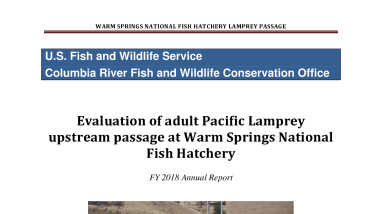Population declines of Pacific Lamprey Entosphenus tridentatus in the Columbia River Basin are partially attributed to impediments to upstream spawning migration of adults. To promote adult Pacific Lamprey passage, fishway modifications have been installed at both high-head and low-head dams across the basin. In 2014, the U.S. Fish and Wildlife Service completed an assessment of the low-head dam and fishway at Warm Springs National Fish Hatchery, Oregon and identified passage deficiencies for adult Pacific Lamprey. In the fall 2017, per the recommendations of the assessment, we installed a Lamprey Passage Structure (LPS) in the fishway and operation began in May 2018. Prior to installation, in 2017, we evaluated adult Pacific Lamprey passage efficiency and route selection at the hatchery using radio telemetry and found that at least some lamprey use the fish ladder to move upstream, exiting at the nearest opening. In June 2018, we began monitoring lamprey passage in the LPS using PIT detection and cameras. A total of 12 lamprey were detected using PIT detections successfully exiting the LPS. Camera monitoring produced excess footage and was difficult to determine lamprey passage. An additional camera was placed underwater at the LPS entrance in the fish ladder to monitor salmonid interactions with the LPS, however no adult salmonids were detected on the footage and no reports of negative impacts of the LPS on salmonids was reported by hatchery biologists. In 2019, the second year of the LPS operation, a PIT antenna will continue to monitor adult lamprey passage and camera monitoring is being refined. The combination of the two monitoring techniques can provide a ratio of tagged to untagged adult lamprey to inform population status in the Warm Springs watershed. The initial success of the LPS at passing adult lamprey is encouraging in its role to facilitate fish passage fish passage
Fish passage is the ability of fish or other aquatic species to move freely throughout their life to find food, reproduce, and complete their natural migration cycles. Millions of barriers to fish passage across the country are fragmenting habitat and leading to species declines. The U.S. Fish and Wildlife Service's National Fish Passage Program is working to reconnect watersheds to benefit both wildlife and people.
Learn more about fish passage and in turn increase the population contribution of Pacific Lamprey in the Warm Springs River to the Columbia River Basin.
Andy Johnsen
Judith Barkstedt
Publication date
Type of document
Annual Report
Facility
Program
Species
FWS Focus
FWS and DOI Region(s)




